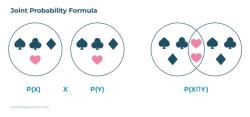What are probability distributions used for?
Probability distributions are a fundamental concept in statistics and probability theory, and they are used for a wide range of applications across various fields. These distributions provide a mathematical framework for describing and modeling uncertainty and randomness in data. Here are some important applications and uses of probability distributions:
Statistical Analysis: Probability distributions are used extensively in statistical analysis to describe the patterns and characteristics of data. They help statisticians summarize data, make inferences, and draw conclusions about populations based on sample data.
Predictive Modeling: Probability distributions are used in predictive modeling, where they help estimate the likelihood of future events or outcomes. This is commonly applied in fields like finance (e.g., estimating stock prices), weather forecasting, and epidemiology (e.g., predicting disease outbreaks).
Risk Assessment: In risk analysis and risk management, probability distributions are used to quantify and assess uncertainty and risk. They help organizations and individuals make decisions in the face of uncertainty, such as determining insurance premiums or assessing investment risks.
Quality Control: Probability distributions are used in quality control and process improvement to monitor and control the variability of manufacturing and service processes. Control charts, for example, rely on probability distributions to determine if a process is in or out of control.
Machine Learning and Data Science: Probability distributions are a fundamental concept in machine learning and data science. They are used in algorithms for pattern recognition, classification, clustering, and regression. Gaussian (normal) distributions are particularly common in these applications.
Engineering and Physics: Probability distributions are used to model physical phenomena and engineering systems. For example, the normal distribution is used to describe the distribution of measurement errors, and Poisson distributions are used in nuclear physics to model the distribution of radioactive decay events.
Finance and Economics: In finance and economics, probability distributions are used to model asset returns, price movements, and economic variables. They are critical for portfolio optimization, risk management, and option pricing.
Healthcare and Medicine: Probability distributions are used in medical research for modeling disease prevalence, treatment outcomes, and the distribution of patient characteristics. They are also used in epidemiology to model disease spread.
Environmental Science: Probability distributions are used in environmental modeling to describe natural processes and phenomena, such as rainfall patterns, temperature variations, and the distribution of pollutants.
Social Sciences: Probability distributions are applied in social sciences to model human behavior, survey responses, and demographic characteristics. They play a role in polling, market research, and sociology.
Simulation: Probability distributions are used in computer simulations to model random events and uncertainty. Monte Carlo simulations, for example, rely on random sampling from probability distributions to estimate complex outcomes.
Probability distributions are essential tools for making sense of uncertainty and variability in data and for making informed decisions in various fields. The choice of the appropriate distribution depends on the nature of the data and the specific application. Understanding probability distributions is a fundamental skill for researchers, analysts, and decision-makers in many disciplines.
The Power of Probability Distributions: Their Practical Applications
Probability distributions are mathematical functions that describe the probabilities of different events happening. They are a powerful tool for modeling and understanding the world around us. Probability distributions have a wide range of practical applications in many different fields, including:
- Finance: Probability distributions are used to model financial markets and to predict the performance of stocks, bonds, and other financial instruments.
- Insurance: Probability distributions are used to set insurance rates and to calculate the risk of different events happening.
- Manufacturing: Probability distributions are used to control quality and to predict the likelihood of defects occurring.
- Healthcare: Probability distributions are used to diagnose diseases, to develop treatments, and to predict patient outcomes.
- Science and engineering: Probability distributions are used to design experiments, to analyze data, and to make predictions about the natural world.
Here are some specific examples of how probability distributions are used in practice:
- A bank might use a probability distribution to model the risk of a customer defaulting on a loan.
- An insurance company might use a probability distribution to set the rates for car insurance.
- A manufacturer might use a probability distribution to control the quality of its products.
- A doctor might use a probability distribution to diagnose a patient's disease.
- A scientist might use a probability distribution to analyze the results of an experiment.
Unlocking the World of Probabilities: How Distributions Are Utilized
Probability distributions are utilized in a variety of ways. For example, they can be used to:
- Make predictions: Probability distributions can be used to make predictions about the future. For example, a company might use a probability distribution to predict the sales of its new product.
- Estimate risks: Probability distributions can be used to estimate the risks of different events happening. For example, an insurance company might use a probability distribution to estimate the risk of a customer's house being damaged by a fire.
- Make decisions: Probability distributions can be used to make informed decisions. For example, a company might use a probability distribution to decide whether or not to launch a new product.
Probability Distributions: Their Crucial Role in Data Analysis
Probability distributions play a crucial role in data analysis. They can be used to:
- Summarize data: Probability distributions can be used to summarize data in a concise and informative way. For example, a company might use a probability distribution to summarize the sales of its product over the past year.
- Identify patterns: Probability distributions can be used to identify patterns in data. For example, a scientist might use a probability distribution to identify patterns in the results of an experiment.
- Test hypotheses: Probability distributions can be used to test hypotheses about data. For example, a company might use a probability distribution to test the hypothesis that its new product is selling better than its old product.
Overall, probability distributions are a powerful tool for modeling and understanding the world around us. They have a wide range of practical applications in many different fields.











